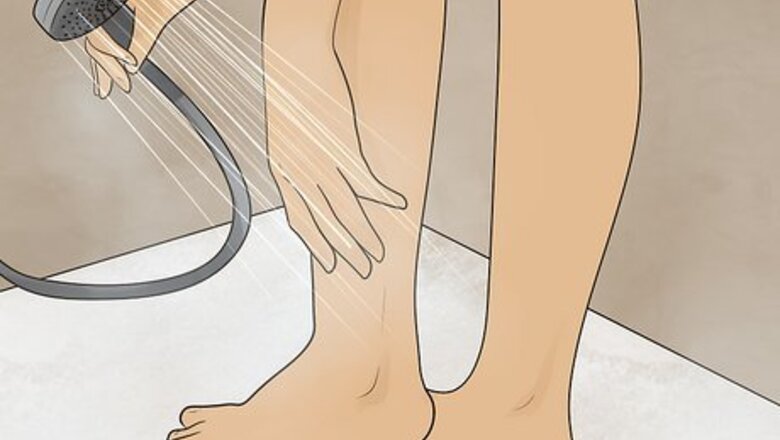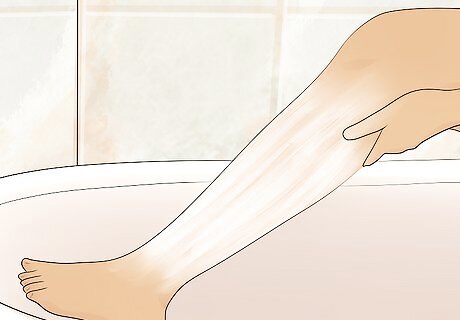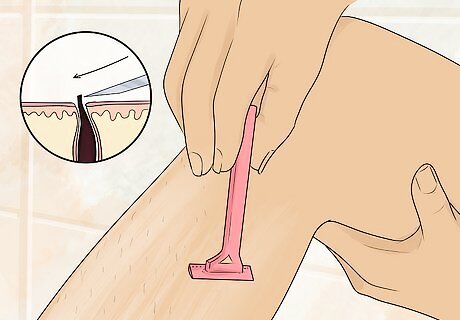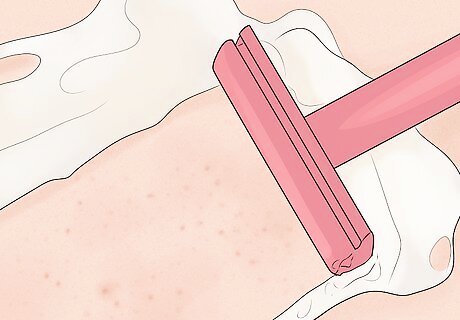
views
- Take a hot shower and wash your skin with a salicylic acid (SA) cleanser. If you don’t take a shower, put a hot towel on the area for five minutes.
- Use a soothing, moisturizing shaving cream that’s free of fragrances and a new, sharp razor.
- Shave with the grain first, then go back over against the grain with light, quick strokes. Finish by washing your face with cold water and an SA cleanser.
How to Shave Against the Grain

Take a hot shower and wash the area you’re shaving. While you’re in the shower, use a gentle salicylic acid wash, like CeraVe’s SA Cleanser to wash the area you’re working with. This gets your skin ready for the shave and blasts away unwanted bacteria. If you don’t want to take a shower, hold a hot towel over the area for five minutes to open your pores. Gentle face cleansers are also perfectly fine, but if you’re shaving somewhere that hosts a lot of bacteria (underarms, pubic area), the salicylic acid helps lower your chances of getting an infection. Gently exfoliating your skin before shaving also helps reduce the risk of getting ingrown hairs.

Apply a soothing, moisturizing shaving cream. A lot of products on the market claim to be soothing, but don’t be fooled. Any product with fragrance, menthol, or essential oils (besides tea tree oil) causes more irritation than it soothes. Use a mild, unscented cream like Aveeno’s Theraputic Shave Gel or Vanicream’s Shave Cream. Conditioner also works as a good lubricant, as long as it’s also fragrance free and for sensitive skin. Use a shave brush instead of just your hands to apply the cream. The bristles pull the hairs upward and make them easier to shave.

Use a new, sharp razor. Dull razors tug on your hairs and cause razor burn, bumps, and general irritation. For the best shave, replace your blades (or razor head) after every 5-7 uses. Get razors with two blades or fewer: the more blades, the more it pulls on your skin. Sensitive skin razors, like Gillette SkinGuard are specially designed to protect from irritation. Fully dry your razor once you’re done using it. If it stays wet and gets rusty, it’ll become duller much, much faster. Safety razor blades come in packs of 100s, so it’s easy to switch them out every day.

Start by shaving with the grain. Run your hand over the area you’re shaving to figure out which direction your hair grows. When you rub against the grain, you’ll feel a resistance, like petting a dog’s hair the wrong way. Lightly shave in the same direction as the grain, and rinse your razor after every pass. Shaving with the grain is the easiest way to prevent skin irritation, and it may give a shave that’s close enough for you to be satisfied, especially if you followed the routine above. If you’re having trouble determining which direction your hair grows (it can grow in many directions in any given area) take a picture and use it as a reference while you’re shaving. This is especially useful for areas like your neck.

If the first pass isn’t close enough, go back against the grain. Gently pull your skin taut, then use short, quick movements to shave in the opposite direction of your hair growth. This process is usually more pleasant on less sensitive areas, like your legs. Be careful if you have acne or bumps on your skin. Shaving against the grain can knick bumps and cause acne to get worse, so shave very lightly and stop going against the grain if it’s painful. If your skin is reacting poorly to shaving against the grain, try shaving sideways to the grain, first. It still gets closer to the base of the hairs than going with the grain, but it’s more gentle than going against it. Run your razor perpendicular to the grain of your hair with short, light movements.

Wash your face with an unscented cleanser and cold water. Now that you’re done shaving, it’s time to close your pores and minimize any chance of infection or ingrown hairs. Use your salicylic acid cleanser again (or a gentle, unscented face or body soap), and this time rinse it off with cold water to close your pores. Use a retinoid cream before going to bed at night to prevent ingrown hairs. Don’t use commercial aftershave products—they’re drying and filled with fragrances that can irritate your skin. Use an unscented, gentle moisturizer after shaving if you have dry skin or are experiencing razor burns, bumps, or general irritation. Aloe vera and hydrocortisone cream can both help soothe razor burn.
Pros & Cons of Shaving Against the Grain

Pros The only upside of going against the grain is a super smooth shave that sometimes can’t be accomplished by any other method. Not everyone has an adverse reaction to shaving against the grain, but consider trying a patch test before going all out on your face or body.

Cons Some people’s anatomy makes shaving against the grain very painful, and it can cause ingrown hairs, bumps, and irritation. If you have curly hair, you’re more likely to get razor burn, which is caused when short, shaved hairs curl back and puncture the skin. If you’re experiencing these problems, stop shaving altogether until they subsist.


















Comments
0 comment